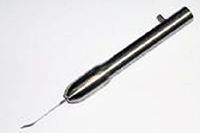Article
Outpatient radiotherapy shows promise in AMD feasibility study
Author(s):
Kaihai, HI-An intraocular epiretinal radiotherapy system (NeoVista Inc.) used during partial vitrectomy has provided encouraging results from a feasibility study of radiation to treat age-related macular degeneration (AMD), said Andrew P. Schachat, MD, here at the Royal Hawaiian Eye Meeting.

Dr. Schachat, vice chairman for clinical affairs, Cole Eye Institute, Cleveland Clinic, Cleveland, described how the system works. The device is not yet approved by the FDA, but pivotal trials will begin shortly, he said.
Epiretinal radiotherapy device

The device is made up of two components: a reusable strontium-90 applicator and a multichannel tester. The applicator is a 20-gauge instrument that delivers radiation directly to the macula; a retina specialist must be certified as the administrator. The size of the applicator is one that is familiar to retina specialists. The multichannel tester is used for source verification to confirm radiation activity before each treatment, according to Dr. Schachat.
The device works as follows. Strontium-90 is attached to the distal end of a guide wire. A lever extends the wire to the tip of a cannula and then retracts within Densamet housing after the treatment.

Encouraging data
The objective of the Protocol NVI-0068 was to evaluate the safety and feasibility of the epiretinal delivery of radiation for the treatment of subfoveal CNV in patients with AMD. The investigators looked at adverse events, radiation-specific adverse events, the ETDRS visual acuity, and the lesion response (lesion size, CNV size, leakage).
The inclusion criteria included no previous treatment for AMD; age of 55 years or older; the presence of subfoveal CNV of any composition; lesion size of 12 or less Macular Photocoagulation Study (MPS) disc areas in the study eye; and a best-corrected visual acuity of about 20/70 to 20/400 in the study eye.
Newsletter
Don’t miss out—get Ophthalmology Times updates on the latest clinical advancements and expert interviews, straight to your inbox.




